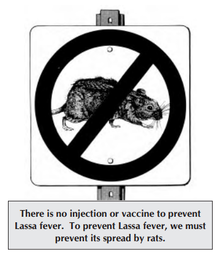Last year, an haemorrhagic fever known as Ebola, found its way into Africa and the world at Large. This year, an acute viral haemorrhagic illness known as Lassa fever is now in "vogue". The Lassa fever, is caused by Lassa Virus and it is transmitted to humans from contacts with food or household items contaminated with rodent excreta. This disease is native in the rodent population in Parts of West Africa. Person-to-person infections and laboratory transmission can also occur, particularly in the hospital environment in the absence of adequate infection control measures. Diagnosis and prompt treatment are essential.
Lassa fever was first described in 1969 in the town of Lassa, in Borno State, Nigeria. And recently about 40 deaths have been recorded in Nigeria due to lassa ever well I guess the fever is back..Lassa virus is zoonotic (transmitted from animals), in that it spreads to humans from rodents, specifically multimammate mice. This is probably the most common mouse in equatorial Africa, ubiquitous in human households and eaten as a delicacy in some areas. In these rodents, infection is in a persistent asymptomatic state. The virus is shed in their excreta (urine and feces), which can be converted. It is possible to acquire the infection through broken skin or mucous membranes that are directly exposed to infectious material. Transmission from person to person has also been established, presenting a disease risk for healthcare workers. Frequency of transmission by sexual contact has not been established.
In West Africa, where Lassa is most prevalent, it is difficult for doctors to diagnose due to the absence of proper equipment to perform tests. In cases with abdominal pain, diagnoses in countries where Lassa is endemic are often made for other illnesses, such as appendicitis and intussusception (where the intestine fold into one another), delaying treatment with ribavirin.
All persons suspected of Lassa fever infection should be admitted to isolation facilities and their body fluids and excreta properly disposed of.
Early and aggressive treatment using ribavirin was pioneered by Joe McCormick in 1979. After extensive testing, early administration was determined to be critical to success. Additionally, ribavirin is almost twice as effective when given intravenously as when taken by mouth. Ribavirin is a pro-drug which appears to interfere with viral replication by inhibiting RNA-dependent nucleic acid synthesis, although the precise mechanism of action is disputed. The drug is relatively inexpensive, but the cost of the drug is still very high for many of those in West African states. Fluid replacement, blood transfusion, and fighting hypotension are usually required. Intravenous interferon therapy has also been used
About 15-20% of hospitalized Lassa fever patients will die from the illness. The overall mortality rate is estimated to be 1%, but during epidemics, mortality can climb as high as 50%. The mortality rate is greater than 80% when it occurs in pregnant women during their third trimester; fetal death also occurs in nearly all those cases. Abortion decreases the risk of death to the mother. Some survivors experience lasting effects of the disease.
Because of treatment with ribavirin, fatality rates are continuing to decline. While most humans are infected either from contact with an infected rat or inhalation of air contaminated with rat excretions, like other hemorrhagic fevers, Lassa fever can be transmitted directly from one human to another. It can be contracted through direct contact with infected human blood excretions and secretions, including through sexual contact. No evidence of airborne transmission person-to-person is seen. Transmission through breast milk has also been observed.
SOURCE: Wikipedia and WHO
SOURCE: Wikipedia and WHO



Enter your comment...Oռʟʏ Gօɖ աɨʟʟ ɦɛʟք ʊs tօօ ʄʀօʍ ɖɨs ɖʀɛaɖʄʊʟ ʋɨʀʊs ɨռ Nɨɢɛʀɨa
ReplyDeleteOռʟʏ Gօɖ աɨʟʟ ɦɛʟք ʊs tօօ ʄʀօʍ ɖɨs ɖʀɛaɖʄʊʟ ʋɨʀʊs ɨռ Nɨɢɛʀɨa
ReplyDeleteamen
Deleteamen
DeleteIt actually is hard to control because one can't completely get rid of rodents in his/her surroundings. Those things are sneaky. I hate them.
ReplyDelete